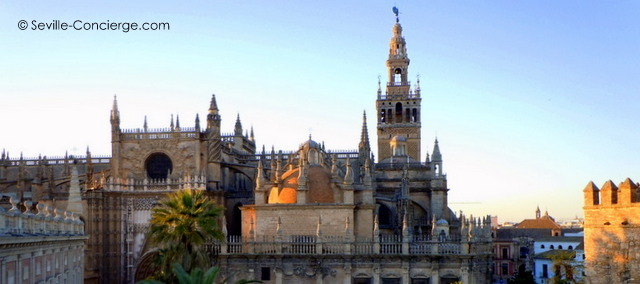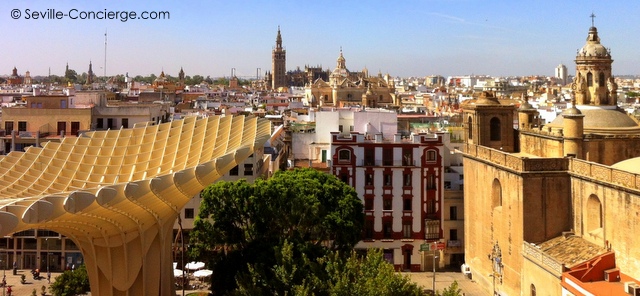We have another guest post this week, this time from former Londoner
and long-term Seville resident Peter Tatford, aka Seville Concierge

With an enticing combination of historical atmosphere, fine weather, local colour, and a growing reputation for good food and wine, Seville has become one of Europe’s top destinations for short break holidays. If you’re travelling with a family or as a group, or simply want more independence than a hotel gives you, renting a self-catering holiday apartment may well be a good option, and there are plenty to choose from in Seville.
The labyrinth of small narrow streets can make Seville a difficult city to find your way around, so you’ll need a good map. A thoughtful apartment owner should provide one, or you can get one from the main Tourism Office in the Plaza San Francisco, on the corner next to Bar Laredo. The staff there are very helpful and you can also use the computers. There is another office on the Avenida de la Constitución near the Puerta de Jerez.
Here is my quick guide to getting the best out of a two-night stay in Seville.
Day One
Afternoon
On your first day in a strange city it’s a good idea to get a sense of direction. In Seville the main axis runs from the geographical centre of the city at Plaza del Duque (with El Corte Inglés department store) and La Campana, along the two parallel main shopping streets of Tetuan and Sierpes to the Plaza Nueva (the big open square with the statue in the middle) and Plaza San Francisco (the much older cobbled square on the other side of the town hall), and on to the Avenida de la Constitución, the modern-looking street with the trams that runs to the Puerta de Jerez, passing in front of your first stop, the Cathedral.
The statistics are all about size – the largest gothic cathedral and third largest church in the world, with the largest gold altarpiece – but none of that tells you about the sense of space that you get inside, or the artistic treasures it’s home to. Look out for the Tomb of Christopher Columbus, and for something more whimsical, the crocodile. Climbing the city’s most famous icon, the Giralda tower is a must (it has ramps rather than stairs, so it’s not too arduous), both so you can say you’ve done it, and also for the views, which are the best in Seville. The tower and the Patio de los Naranjos are all that remains of the Grand Mosque that occupied the site until the beginning of the 15th century, when work began on the new cathedral.
Cathedral (including the Giralda Tower)
Avda de la Constitución
Opening hours: Sep-June Mon-Sat 11.00-17.30 / Suns 14.30-18.30
July and August Mon-Sat 09.30-16.30 Suns / 14.30-18.30
Entrance €8, Pensioners and students €3, Free to residents, disabled and under 15s
Behind the cathedral is the Plaza Virgen de los Reyes, probably one of the most beautiful squares in the world, encircled by the Cathedral, the Archbishop’s Palace, and the Church of Santa Marta, and with its gargoyle fountain and farola (literally streetlamp, but it loses something in the translation) in the centre. There will soon be a new statue installed of Pope John Paul II. Opposite the cathedral is Mateos Gago street, until a hundred years ago the only way into the Barrio Santa Cruz. This would be a good time for a short siesta in preparation for your first night on the town.
Evening
A great way to get your bearings, experience a proper Sevillian “tapeo” (tapas crawl) and try some of the best food Seville has to offer, is to take one of Shawn Hennessey’s excellent Sevilla Tapas Tours. You’ll eat like a local and learn a lot about Spanish food and wine.
Day Two
Morning
Start the day with the best tostadas and coffee in Seville at the Horno San Buenaventura. Sit at the bar with the locals where the service is faster and cheaper, and order your coffee “en vaso” (in a glass). You can also choose something from the pastry counter to keep you going through the morning.
From here, turn right onto Constitución and go round the cathedral into the Plaza Triunfo and the Alcázar Royal Palace and Gardens (Reales Alcázares). This is undoubtedly the city’s number one tourist attraction, and it’s not hard to see why. The impressive outer walls date from the Moorish period, and the main palace from the mid-14th century, about a hundred years after the Christian reconquest. It was built by Peter the Cruel, and is one of the best examples of mudejar-style architecture in Spain, full of fabulous tiled courtyards and amazing ceilings. In the gardens look for the Baths of Doña María Padilla, the Pool of Mercury, and the Wall of the Grotesques. You can expect to spend at least two hours here, and it’s worth investing in an audio guide, which has lots of information without being overwhelming.
Plaza del Triunfo
Opening hours Oct-Mar 9.30-17.00 Apr-Sep 9.30-19.00
Closed Jan 1,6 Good Friday and Dec 25
Entrance €8.50 Pensioners and students €2 Free to residents, disabled and under 16s
When you exit the palace you will find yourself in the orange-tree-lined Patio de Banderas. From here turn right under the arches and take in the picturesque atmosphere of the old Jewish quarter of the city, with its narrow streets, small squares, orange trees and balconies. This is a great area to just wander round, but look out for the Plazas Doña Elvira and Los Refinadores and Calle Agua (Water Street) beside the old wall in particular, and take a detour into the Murillo Gardens, just because they’re there.
Afternoon
At the northern end of the Murillo Gardens you’ll find one of my favourite tapas bars in the Paseo Catalina de Ribera. Vineria San Telmo has a special buzzy atmosphere, a terrific eclectic menu and attentive international staff.
From the Vineria it’s a short walk to the Plaza de España in Maria Luisa Park. Designed by Seville’s most famous architect, Aníbal González for the 1929 Ibero-American exhibition, it’s an ornately columned semi-circular building with representations of all the provinces of Spain, around a grand plaza with a central fountain, and a boating lake with bridges, all with a great profusion of colourful ceramic decoration. Depending on the time and the weather an alternative route back is across the park to the river, and along the river bank to the Palacio San Telmo (unfortunately not open to the public), and the Torre del Oro, another of the city’s icons.
Evening
No holiday in Seville would be complete without taking in a flamenco show. A particularly good one can be enjoyed at the Flamenco Museum. Unlike at the other venues, this one is early enough in the evening that you can comfortably see the show and have dinner afterwards.
Museo de Baile Flamenco
Manuel Rojas Marcos, 3
Opening hours 9.30-19.00 (museum) 19.00- 20.00 (show)
Entrance €10, students €8, children €6, groups €8 per person
Splash out for some gourmet tapas at La Azotea, where you are guaranteed to have some of the most innovative and tasty tapas in town. They don’t take bookings so be sure to get there at opening time (8.30 pm) to get a table.
After dinner, it’s time to finish your day with a touch of style. These days there are plenty of rooftop bars where you can enjoy a late cocktail or two while taking in lovely views but one of my favourites is in the Hotel Doña Maria in Calle Remondo, just off the Plaza Virgen de los Reyes behind the cathedral.
Day Three
Morning
Time to try some churros and chocolate (or with coffee if you prefer). One very traditional place near your final “must see” is the Centurion Bar in the Plaza Encarnación just behind the market. After breakfast it’s time for something completely different – and this place would be completely different anywhere in the world.
The Metropol Parasol, or “Las Setas” (mushrooms), as they are known locally for reasons that will be obvious when you see them, have only been open for two years, but have already helped breathe new life into this neighbourhood of Seville. Not only do these huge waffle-like creations make up the largest wooden structure in the world, they also serve practical functions. At ground level they house the Encarnación Market, worth visiting for the colourful and occasionally exotic displays of fresh fruit and veg, fish and seafood, and meats and charcuterie. Below ground level is the Antiquarium, a well thought out museum of mainly Roman ruins, including some well-preserved mosaics. Take the lift from this basement level to the top where there are great views of the city from the walkways, and enjoy a bite at Gastrosol where you can find anything from fried fish and charcuterie to gourmet burgers and designer tapas.
Espacio Metropol Parasol
Plaza de la Encarnación
Opening hours: (Miradores) Sun-Thur 10.30-00.00 Fri-Sat 10.30-01.00
(Antiquarium) Mon-Sat10.00-20.00 / Sun 10.00-14.00pm / closed on Mondays

Peter Tatford
Seville Concierge
Thank you for this most useful guide. I am planning to spend 2 months in Seville during Jan/Feb 2017. I will print your guide and take it with me to my holiday rented flat. I will soon be paying my reservation fee then the balance when I receive the keys to my dream apartment (with private roof terrace).
Any tips you can give me for my holiday would be much appreciated. Perhaps we could meet for a coffee when I arrive.
Best Wishes,
Julia
I followed your recommendation for the must see Centurion Bar and am looking at it now refusing to enter as it looks dismal and quite awful really. Sorry what exactly was so spectacular about it? It has modern awful depressing white lights like some corner supermarket and plastic chairs albeit colorful. Why would I want to spend time here when it looks so terribly uninspiring?
Pingback: Witchcraft Manual is good